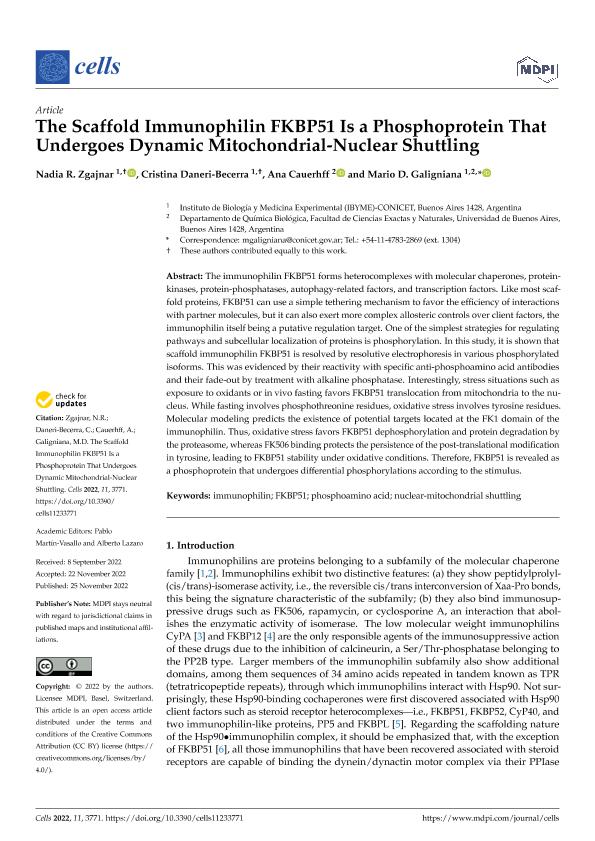Artículo
The Scaffold Immunophilin FKBP51 Is a Phosphoprotein That Undergoes Dynamic Mitochondrial-Nuclear Shuttling
Zgajnar, Nadia Romina ; Daneri Becerra, Cristina del Rosario
; Daneri Becerra, Cristina del Rosario ; Cauerff, Ana Albina
; Cauerff, Ana Albina ; Galigniana, Mario Daniel
; Galigniana, Mario Daniel
 ; Daneri Becerra, Cristina del Rosario
; Daneri Becerra, Cristina del Rosario ; Cauerff, Ana Albina
; Cauerff, Ana Albina ; Galigniana, Mario Daniel
; Galigniana, Mario Daniel
Fecha de publicación:
12/2022
Editorial:
MDPI
Revista:
Cells
ISSN:
2073-4409
e-ISSN:
2073-4409
Idioma:
Inglés
Tipo de recurso:
Artículo publicado
Clasificación temática:
Resumen
The immunophilin FKBP51 forms heterocomplexes with molecular chaperones, protein-kinases, protein-phosphatases, autophagy-related factors, and transcription factors. Like most scaffold proteins, FKBP51 can use a simple tethering mechanism to favor the efficiency of interactions with partner molecules, but it can also exert more complex allosteric controls over client factors, the immunophilin itself being a putative regulation target. One of the simplest strategies for regulating pathways and subcellular localization of proteins is phosphorylation. In this study, it is shown that scaffold immunophilin FKBP51 is resolved by resolutive electrophoresis in various phosphorylated isoforms. This was evidenced by their reactivity with specific anti-phosphoamino acid antibodies and their fade-out by treatment with alkaline phosphatase. Interestingly, stress situations such as exposure to oxidants or in vivo fasting favors FKBP51 translocation from mitochondria to the nucleus. While fasting involves phosphothreonine residues, oxidative stress involves tyrosine residues. Molecular modeling predicts the existence of potential targets located at the FK1 domain of the immunophilin. Thus, oxidative stress favors FKBP51 dephosphorylation and protein degradation by the proteasome, whereas FK506 binding protects the persistence of the post-translational modification in tyrosine, leading to FKBP51 stability under oxidative conditions. Therefore, FKBP51 is revealed as a phosphoprotein that undergoes differential phosphorylations according to the stimulus.
Palabras clave:
FKBP51
,
IMMUNOPHILIN
,
NUCLEAR-MITOCHONDRIAL SHUTTLING
,
PHOSPHOAMINO ACID
Archivos asociados
Licencia
Identificadores
Colecciones
Articulos(IBYME)
Articulos de INST.DE BIOLOGIA Y MEDICINA EXPERIMENTAL (I)
Articulos de INST.DE BIOLOGIA Y MEDICINA EXPERIMENTAL (I)
Articulos(OCA CIUDAD UNIVERSITARIA)
Articulos de OFICINA DE COORDINACION ADMINISTRATIVA CIUDAD UNIVERSITARIA
Articulos de OFICINA DE COORDINACION ADMINISTRATIVA CIUDAD UNIVERSITARIA
Citación
Zgajnar, Nadia Romina; Daneri Becerra, Cristina del Rosario; Cauerff, Ana Albina; Galigniana, Mario Daniel; The Scaffold Immunophilin FKBP51 Is a Phosphoprotein That Undergoes Dynamic Mitochondrial-Nuclear Shuttling; MDPI; Cells; 11; 23; 12-2022; 1-13
Compartir
Altmétricas



